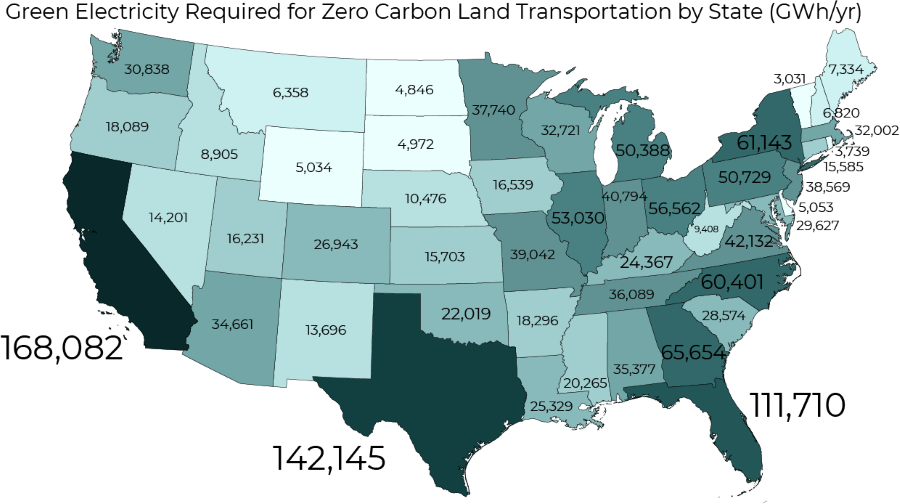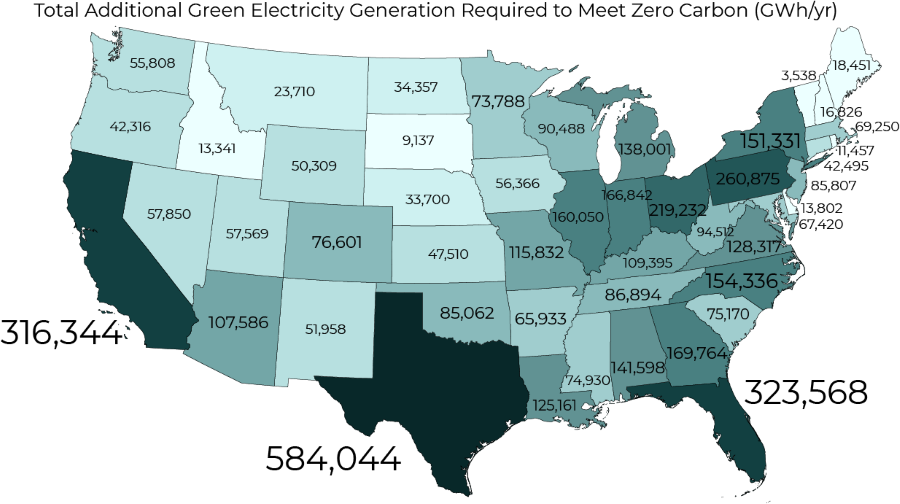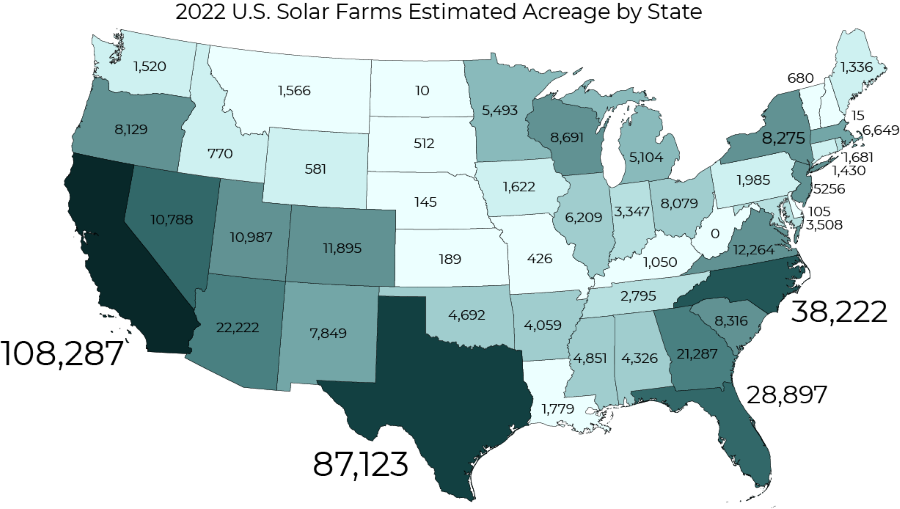Editor's Note: The author of this article is Yoann Hispa, CEO and Co-Founder of LandGate. It was originally published in the Summer 2022 edition of Land.
Assuming fossil fuel and biomass energy would be replaced with green energy, it would take 13 million acres of America’s land to obtain zero-carbon emission by generating electricity solely from solar farms. The amount would likely need to double to account for energy storage, electric vehicle (EV) charging stations, and the necessary increase in electrical infrastructure. By dedicating about 26 million acres or one percent of US land to solar energy—an area roughly the size of Kentucky—we could enable the nation to reach zero carbon emission.
Figure 1 shows the yearly equivalent electricity production (as of May 2022) broken down by source. Green energy includes solar, wind, hydroelectric, and geothermal electricity. Nuclear energy is considered a zero-carbon electricity generation method. Low-carbon energy is natural gas, which the European Union is trying to include, amid controversy, as a type of green energy meeting the carbon goals. High-carbon electricity is produced from coal, petroleum, and biomass sources. Even though biomass is a renewable energy source, it requires burning wood and plants, creating problematic carbon emissions. Texas is the nation’s leading producer of electricity and overall energy.
(1).png)
Figure 1
To calculate the electricity demand for the US, both infrastructure electricity data and land transportation were incorporated into this study. According to an EIA study, on-road passenger transportation accounts for 62% of the transportation energy use in the US, with the rest being freight transportation (19%), marine (12%), air (5%), and rail (2%). In this feasibility study, we will assume that only land transportations (on-road passenger, freight, and rail) can be completely electrified.
Using the driving statistics from the US Department of Transportation, LandGate estimated the average yearly car mileage per driver for each state which ranges from 7,013 miles per year for the District of Columbia to 24,069 miles per year for Wyoming. Combined with the number of licensed drivers for each state, we can derive the yearly mileage per state for on-road passengers.
Since EVs in the US account for less than one percent of all vehicles, and because we are not modeling an increase in the number of drivers, we will assume all vehicles are petroleum based. Using an average EV energy consumption of 350 Wh (Watthour) per mile, and with more modeling, we converted this to a total energy consumption to turn the entire passenger vehicle fleet, along with freight and rail transportation, to electric, (See Figure 2.)
.png) Figure 2
Figure 2
Utility-scale generators in the US currently generate around 4.7 million GWh per year, with 1.8 million GWh produced from high carbon emission sources of energy and 1.6 million GWh from low-carbon emission natural gas. The electricity needed to make land transportation totally zero carbon is estimated at 1.6 million GWh per year. To make the current electricity production and land transportation zero-carbon emission will require five million GWh per year of additional electricity generation from green energy.
(Figure 3 and Figure 4 show the breakdown of this additional green electricity required for each state to have no carbon emissions.) Which source of green energy will likely be used to produce these five million GWh per year of additional electricity? Growing calls for removing hydroelectric dams combined with increasing droughts, as illustrated by the Glen Canyon Dam in Arizona’s Lake Powell where water levels have dropped to a historic low, do not make new hydroelectric dams likely.
 Figure 3
Figure 3
 Figure 4
Figure 4
Wind farms take more acreage than solar to produce the same electricity, but they allow use of the land. To simplify this feasibility study, we will assume that all the additional electricity from green energy sources will come from solar farms. Using the solar irradiance, topography, exclusion zones, buildable acreage specific to every state, we calculated the acreage required to generate this additional electricity. (See Figure 5.)
.png) Figure 5
Figure 5
Solar farms in the US built and being built to date currently occupy an estimated half million acres. We would need an additional 13 million acres of solar farms in the next decade to meet the zero carbon goals, over 25 times more than what has been built to date (See Figure 6.).

Figure 6
It would also require additional energy storage, infrastructures like transmission lines, substations, and distribution lines, which could be roughly estimated to be another 13 million acres. This Kentucky-size acreage required for green electricity production, transportation, and storage represents around one percent of the land in the continental United States. The first step in this energy transition is replacing the high carbon energy sources (coal and fossil fuels). The next step will be replacing the low-carbon energy sources (natural gas). Given the recent focus from investors on renewable energy, we want to believe these zero-carbon goals can be met, which will require that a lot of land across the US be dedicated to green energy production.
LandGate, a data intelligence and marketplace for land and its resources, provided the data for this article.
Landowners: LandGate provides free data for landowners to help determine the value of your land when it comes to solar farm potential, wind farm potential, minerals, carbon credits, or any other resource. Find your land values at LandGate.com
Land Real Estate Agents: Get access to the only data intelligence for land resources. Bring this unique knowledge to your clients. Access the $4 trillion a year of energy and environmental deals. LandGate’s marketplace gives access to the largest network of corporate buyers paying top-dollar for land and its resources.